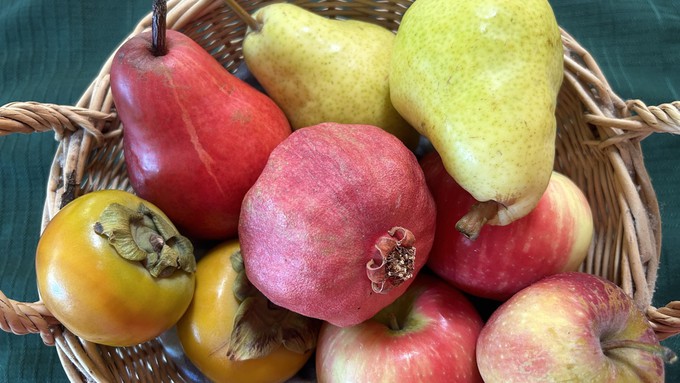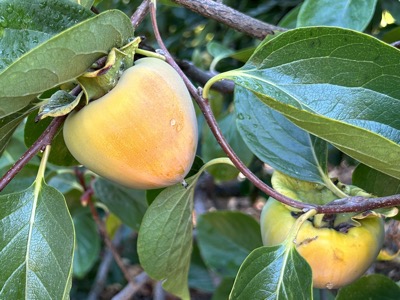
Conversation with Kathy Morrison delves into persimmons, baked goods and season-bridging salads

The gorgeous colors of fall fruit: pears, apples, persimmons (those are Fuyus) and a pomegranate. We have recipes for all of these in Taste Fall! Kathy Morrison
Fred Hoffman always is a favorite visitor to the Fair Oaks Horticulture Center on Open Garden Days. A lifetime master gardener himself, he'll often flag down one of the Sacramento master gardeners to discuss a seasonal topic, such as worm composting or cover crops or fruit tree pruning, for his podcast "Garden Basics with Farmer Fred."
He and I had a fun conversation at the year's final Open Garden, on Oct. 11, about the latest Sacramento Digs Gardening online cookbook, Taste Fall! Everyone else can listen in Friday, Oct. 27, when an edited version goes live on the podcast home page.

We discuss recipes for all those fall fruits shown in the photo above, as well as Hachiya persimmons. (The photo at right shows some of the still-ripening Hachiyas at the Horticulture Center.) The cookbook also includes recipes incorporating vegetables such as winter squash, pumpkins and Brussels sprouts.
And what about that big salad that's the featured photo in the cookbook? That's our Provence-inspired dinner salad, which we loaded up with everything fresh we could find in a south-of-France farmers market a year ago. Since Sacramento has a similar Mediterranean climate, it's an easy recipe to recreate (or adapt to personal taste) from produce at our local farmers markets. It truly celebrates our long growing season and the range of fresh food available nearby.
Check out Fred's earlier podcasts, too. The Oct. 20 episode with Don Shor of Davis' Redwood Nursery, in which they wrap up the 2023 tomato-growing season, is a must for vegetable gardeners.
Look for Sacramento Digs Gardening's Taste Winter! cookbook in late December or early January, after the holiday rush.
In the meantime, check out some cool ways to preserve fall produce, courtesy of the UCCE master food preservers. This link goes to a 26-page pdf that was part of a recent presentation by the Sacramento County master food preservers, "The 4 P's of Fall." (That is, pears, pomegranates, persimmons and pumpkin. Pesto is a bonus.) Many of the recipes involve drying or freezer-preserving, so you don't need a canning kettle or other gear. Good stuff!
Comments
0 comments have been posted.Sacramento Digs Gardening to your inbox.
Food in My Back Yard Series
May 6: Maintain soil moisture with mulch for garden success
April 29: What's (already) wrong with my tomato plants?
April 22: Should you stock up on fertilizer? (Yes!)
April 15: Grow culinary herbs in containers
April 8: When to plant summer vegetables
April 1: Don't be fooled by these garden myths
March 25: Fertilizer tips: How to 'feed' your vegetables for healthy growth
March 18: Time to give vegetable seedlings some more space
March 11: Ways to win the fight against weeds
March 4: Potatoes from the garden
Feb. 25: Plant a fruit tree now -- for later
Feb. 18: How to squeeze more food into less space
Feb. 11: When to plant? Consider staggering your transplants
Feb. 4: Starting in seed starting
Sites We Like
Garden Checklist for week of May 11
Make the most of the lower temperatures early in the week. We’ll be back in the 80s by Thursday.
* Plant, plant, plant! It’s prime planting season in the Sacramento area. Time to set out those tomato transplants along with peppers and eggplants. Pinch off any flowers on new transplants to make them concentrate on establishing roots instead of setting premature fruit.
* Direct-seed melons, cucumbers, summer squash, corn, radishes, pumpkins and annual herbs such as basil.
* Harvest cabbage, lettuce, peas and green onions.
* In the flower garden, direct-seed sunflowers, cosmos, salvia, zinnias, marigolds, celosia and asters. (You also can transplant seedlings for many of the same flowers.)
* Plant dahlia tubers.
* Transplant petunias, marigolds and perennial flowers such as astilbe, columbine, coneflowers, coreopsis, dahlias, rudbeckia and verbena.
* Keep an eye out for slugs, snails, earwigs and aphids that want to dine on tender new growth.
* Feed summer bloomers with a balanced fertilizer.
* For continued bloom, cut off spent flowers on roses as well as other flowering plants.
* Add mulch to the garden to maintain moisture. Mulch also cuts down on weeds. But don’t let it mound around the stems or trunks of trees or shrubs. Leave about a 6-inch-to-1-foot circle to avoid crown rot or other problems.
* Remember to weed! Pull those nasties before they set seed.
* Water early in the day and keep seedlings evenly moist.